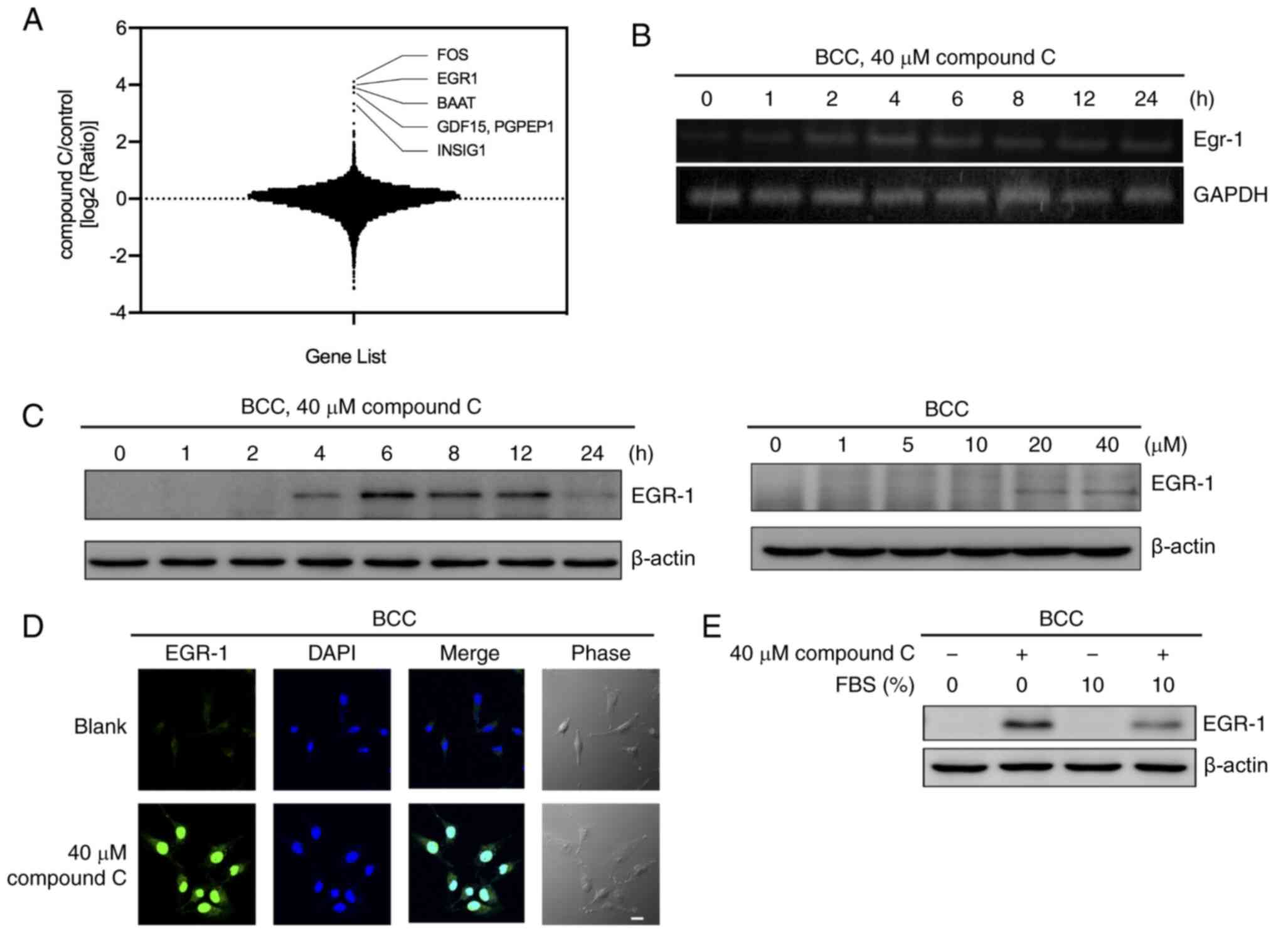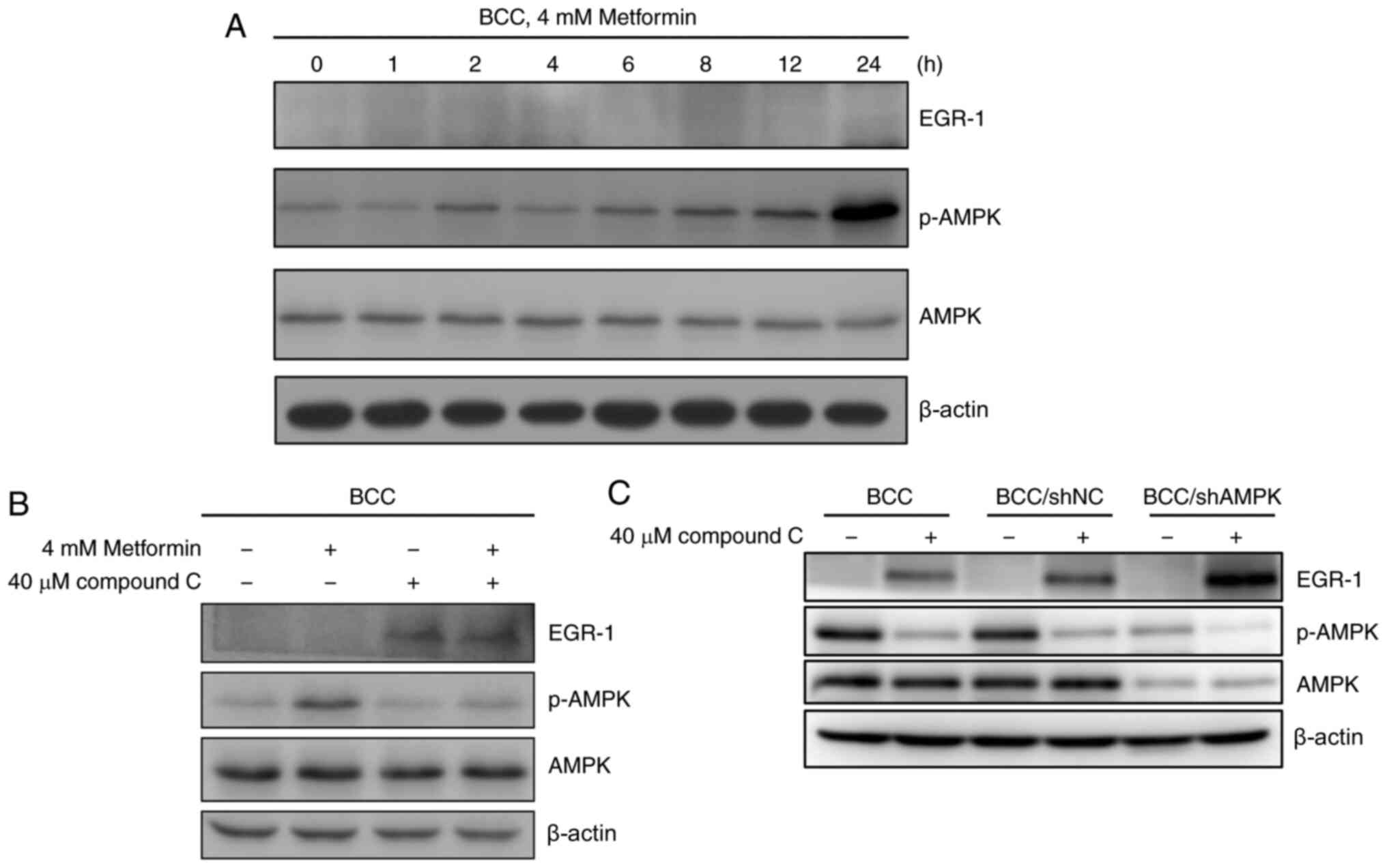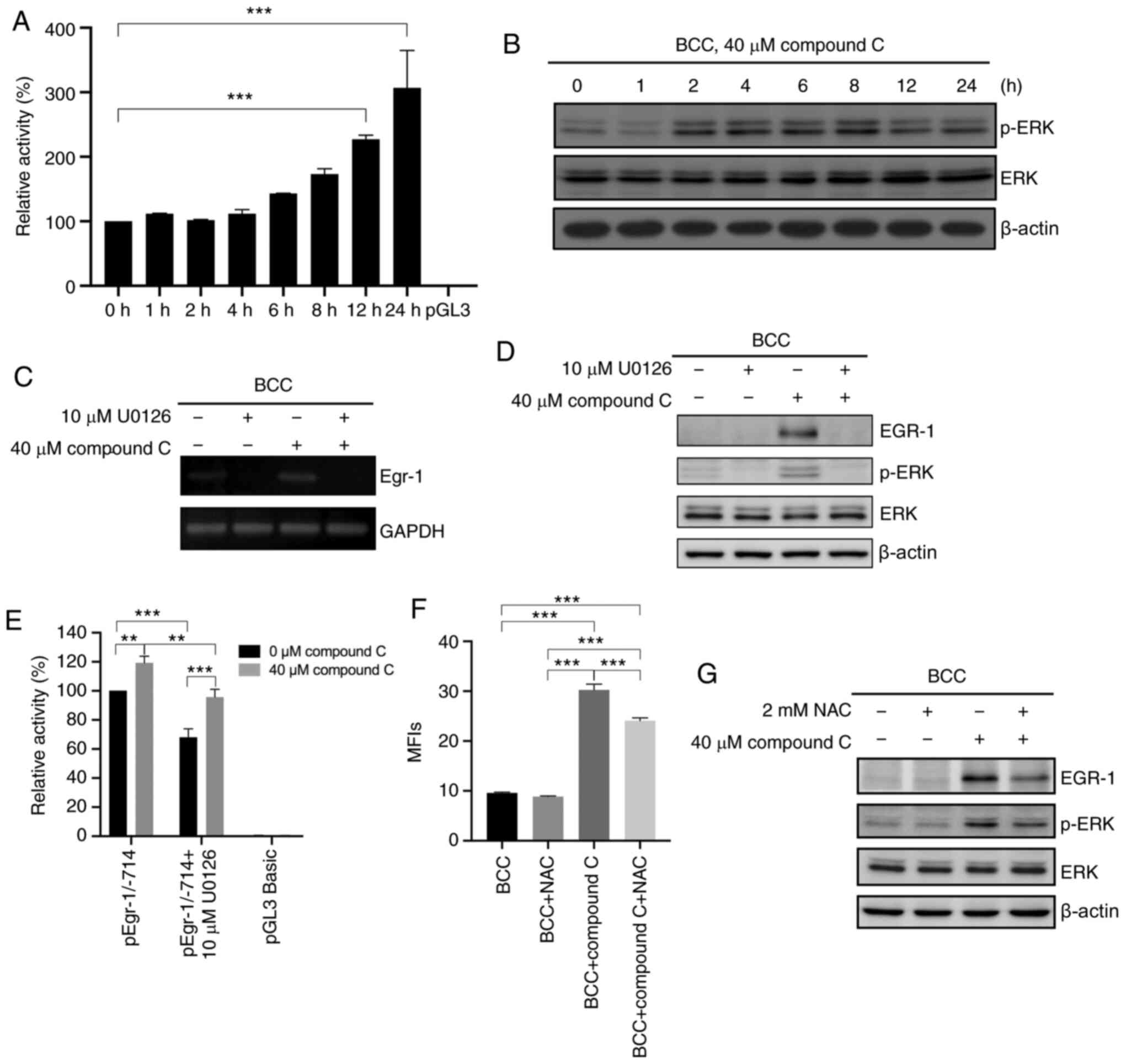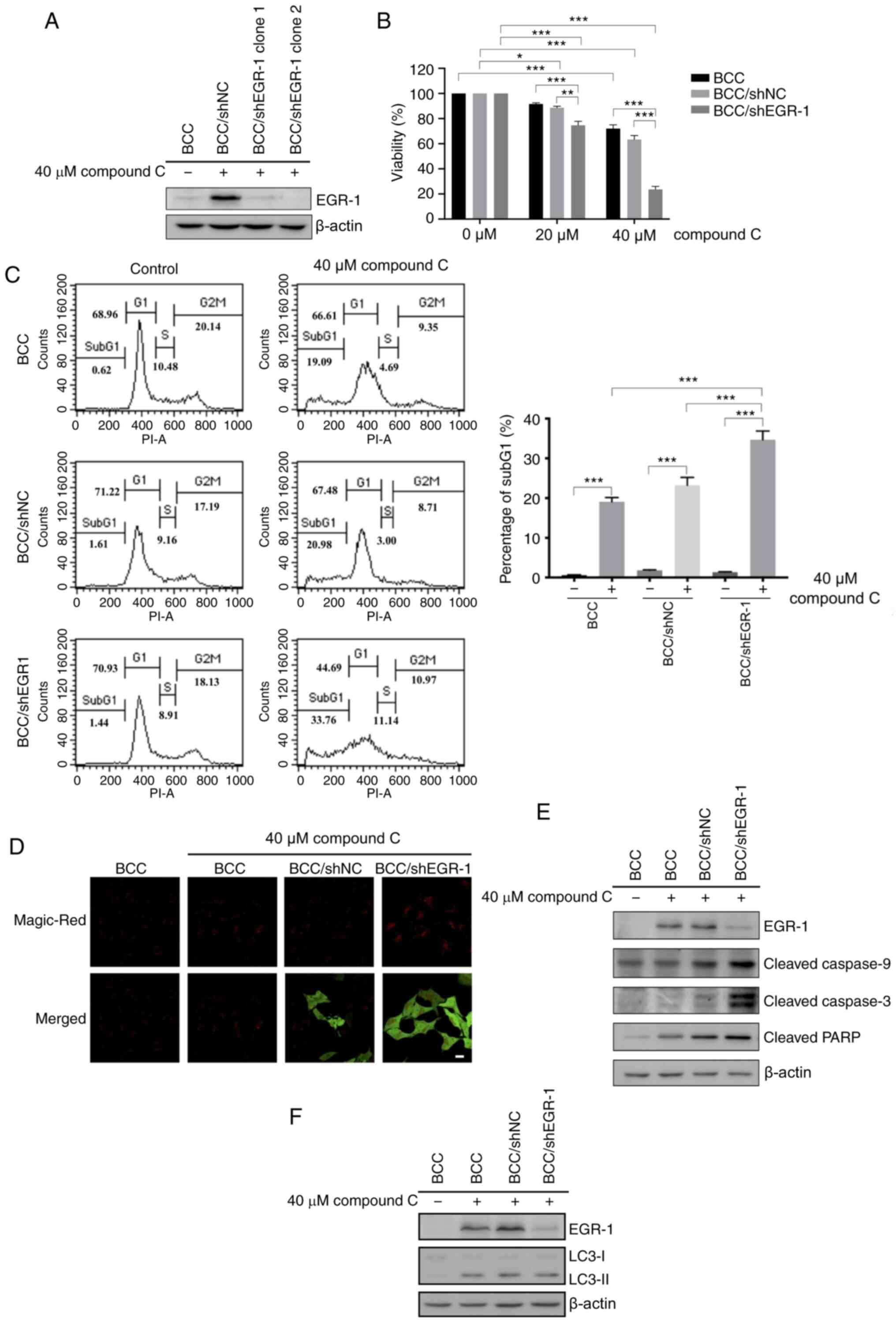|
1
|
Zhou G, Myers R, Li Y, Chen Y, Shen X,
Fenyk-Melody J, Wu M, Ventre J, Doebber T, Fujii N, et al: Role of
AMP-activated protein kinase in mechanism of metformin action. J
Clin Invest. 108:1167–1174. 2001. View
Article : Google Scholar : PubMed/NCBI
|
|
2
|
Bae EJ, Cho MJ and Kim SG: Metformin
prevents an adaptive increase in GSH and induces apoptosis under
the conditions of GSH deficiency in H4IIE cells. J Toxicol Environ
Health A. 70:1371–1380. 2007. View Article : Google Scholar : PubMed/NCBI
|
|
3
|
Vucicevic L, Misirkic M, Janjetovic K,
Harhaji-Trajkovic L, Prica M, Stevanovic D, Isenovic E, Sudar E,
Sumarac- Dumanovic M, Micic D and Trajkovic V: AMP-activated
protein kinase-dependent and -independent mechanisms underlying in
vitro antiglioma action of compound C. Biochem Pharmacol.
77:1684–1693. 2009. View Article : Google Scholar : PubMed/NCBI
|
|
4
|
Jin J, Mullen TD, Hou Q, Bielawski J,
Bielawska A, Zhang X, Obeid LM, Hannun YA and Hsu YT: AMPK
inhibitor compound C stimulates ceramide production and promotes
Bax redistribution and apoptosis in MCF7 breast carcinoma cells. J
Lipid Res. 50:2389–2397. 2009. View Article : Google Scholar : PubMed/NCBI
|
|
5
|
Meley D, Bauvy C, Houben-Weerts JH,
Dubbelhuis PF, Helmond MT, Codogno P and Meijer AJ: AMP-activated
protein kinase and the regulation of autophagic proteolysis. J Biol
Chem. 281:34870–34879. 2006. View Article : Google Scholar : PubMed/NCBI
|
|
6
|
Vucicevic L, Misirkic M, Janjetovic K,
Vilimanovich U, Sudar E, Isenovic E, Prica M, Harhaji-Trajkovic L,
Kravic-Stevovic T, Bumbasirevic V and Trajkovic V: Compound C
induces protective autophagy in cancer cells through AMPK
inhibition-independent blockade of Akt/mTOR pathway. Autophagy.
7:40–50. 2011. View Article : Google Scholar : PubMed/NCBI
|
|
7
|
Jang JH, Lee TJ, Yang ES, Min do S, Kim
YH, Kim SH, Choi YH, Park JW, Choi KS and Kwon TK: Compound C
sensitizes Caki renal cancer cells to TRAIL-induced apoptosis
through reactive oxygen species-mediated down-regulation of c-FLIPL
and Mcl-1. Exp Cell Res. 316:2194–2203. 2010. View Article : Google Scholar : PubMed/NCBI
|
|
8
|
Milbrandt J: A nerve growth factor-induced
gene encodes a possible transcriptional regulatory factor. Science.
238:797–799. 1987. View Article : Google Scholar : PubMed/NCBI
|
|
9
|
Gashler A and Sukhatme VP: Early growth
response protein 1 (Egr-1): Prototype of a zinc-finger family of
transcription factors. Prog Nucleic Acid Res Mol Biol. 50:191–224.
1995. View Article : Google Scholar : PubMed/NCBI
|
|
10
|
Aicher WK, Sakamoto KM, Hack A and Eibel
H: Analysis of functional elements in the human Egr-1 gene
promoter. Rheumatol Int. 18:207–214. 1999. View Article : Google Scholar : PubMed/NCBI
|
|
11
|
Pagel JI and Deindl E: Early growth
response 1-a transcription factor in the crossfire of signal
transduction cascades. Indian J Biochem Biophys. 48:226–235.
2011.PubMed/NCBI
|
|
12
|
Yu J, Baron V, Mercola D, Mustelin T and
Adamson ED: A network of p73, p53 and Egr1 is required for
efficient apoptosis in tumor cells. Cell Death Differ. 14:436–446.
2007. View Article : Google Scholar : PubMed/NCBI
|
|
13
|
Yu J, de Belle I, Liang H and Adamson ED:
Coactivating factors p300 and CBP are transcriptionally
crossregulated by Egr1 in prostate cells, leading to divergent
responses. Mol Cell. 15:83–94. 2004. View Article : Google Scholar : PubMed/NCBI
|
|
14
|
Yu J, Zhang SS, Saito K, Williams S,
Arimura Y, Ma Y, Ke Y, Baron V, Mercola D, Feng GS, et al: PTEN
regulation by Akt-EGR1-ARF-PTEN axis. EMBO J. 28:21–33. 2009.
View Article : Google Scholar : PubMed/NCBI
|
|
15
|
Bae MH, Jeong CH, Kim SH, Bae MK, Jeong
JW, Ahn MY, Bae SK, Kim ND, Kim CW, Kim KR and Kim KW: Regulation
of Egr-1 by association with the proteasome component C8. Biochim
Biophys Acta. 1592:163–167. 2002. View Article : Google Scholar : PubMed/NCBI
|
|
16
|
Kim HS, Hwang JT, Yun H, Chi SG, Lee SJ,
Kang I, Yoon KS, Choe WJ, Kim SS and Ha J: Inhibition of
AMP-activated protein kinase sensitizes cancer cells to
cisplatin-induced apoptosis via hyper-induction of p53. J Biol
Chem. 283:3731–3742. 2008. View Article : Google Scholar : PubMed/NCBI
|
|
17
|
Krones-Herzig A, Mittal S, Yule K, Liang
H, English C, Urcis R, Soni T, Adamson ED and Mercola D: Early
growth response 1 acts as a tumor suppressor in vivo and in vitro
via regulation of p53. Cancer Res. 65:5133–5143. 2005. View Article : Google Scholar : PubMed/NCBI
|
|
18
|
Das A, Chendil D, Dey S, Mohiuddin M,
Mohiuddin M, Milbrandt J, Rangnekar VM and Ahmed MM: Ionizing
radiation down-regulates p53 protein in primary Egr-1−/−
mouse embryonic fibroblast cells causing enhanced resistance to
apoptosis. J Biol Chem. 276:3279–3286. 2001. View Article : Google Scholar : PubMed/NCBI
|
|
19
|
Baron V, Adamson ED, Calogero A, Ragona G
and Mercola D: The transcription factor Egr1 is a direct regulator
of multiple tumor suppressors including TGFbeta1, PTEN, p53, and
fibronectin. Cancer Gene Ther. 13:115–124. 2006. View Article : Google Scholar : PubMed/NCBI
|
|
20
|
Gitenay D and Baron VT: Is EGR1 a
potential target for prostate cancer therapy? Future Oncol.
5:993–1003. 2009. View Article : Google Scholar : PubMed/NCBI
|
|
21
|
Yang SZ and Abdulkadir SA: Early growth
response gene 1 modulates androgen receptor signaling in prostate
carcinoma cells. J Biol Chem. 278:39906–39911. 2003. View Article : Google Scholar : PubMed/NCBI
|
|
22
|
Lu C, Shi Y, Wang Z, Song Z, Zhu M, Cai Q
and Chen T: Serum starvation induces H2AX phosphorylation to
regulate apoptosis via p38 MAPK pathway. FEBS Lett. 582:2703–2708.
2008. View Article : Google Scholar : PubMed/NCBI
|
|
23
|
Huang SW, Wu CY, Wang YT, Kao JK, Lin CC,
Chang CC, Mu SW, Chen YY, Chiu HW, Chang CH, et al: p53 modulates
the AMPK inhibitor compound C induced apoptosis in human skin
cancer cells. Toxicol Appl Pharmacol. 267:113–124. 2013. View Article : Google Scholar : PubMed/NCBI
|
|
24
|
Datta R, Rubin E, Sukhatme V, Qureshi S,
Hallahan D, Weichselbaum RR and Kufe DW: Ionizing radiation
activates transcription of the EGR1 gene via CArG elements. Proc
Natl Acad Sci USA. 89:10149–10153. 1992. View Article : Google Scholar : PubMed/NCBI
|
|
25
|
Kao JK, Wang SC, Ho LW, Huang SW, Lee CH,
Lee MS, Yang RC and Shieh JJ: M2-like polarization of THP-1
monocyte-derived macrophages under chronic iron overload. Ann
Hematol. 99:431–441. 2020. View Article : Google Scholar : PubMed/NCBI
|
|
26
|
Tsai MH, Wang HC, Lee GW, Lin YC and Chiu
SH: A decision tree based classifier to analyze human ovarian
cancer cDNA microarray datasets. J Med Syst. 40:212016. View Article : Google Scholar : PubMed/NCBI
|
|
27
|
Yang WL, Perillo W, Liou D, Marambaud P
and Wang P: AMPK inhibitor compound C suppresses cell proliferation
by induction of apoptosis and autophagy in human colorectal cancer
cells. J Surg Oncol. 106:680–688. 2012. View Article : Google Scholar : PubMed/NCBI
|
|
28
|
Berasi SP, Huard C, Li D, Shih HH, Sun Y,
Zhong W, Paulsen JE, Brown EL, Gimeno RE and Martinez RV:
Inhibition of gluconeogenesis through transcriptional activation of
EGR1 and DUSP4 by AMP-activated kinase. J Biol Chem.
281:27167–27177. 2006. View Article : Google Scholar : PubMed/NCBI
|
|
29
|
Liu DX, Qian D, Wang B, Yang JM and Lu Z:
p300-Dependent ATF5 acetylation is essential for Egr-1 gene
activation and cell proliferation and survival. Mol Cell Biol.
31:3906–3916. 2011. View Article : Google Scholar : PubMed/NCBI
|
|
30
|
Cao X, Mahendran R, Guy GR and Tan YH:
Protein phosphatase inhibitors induce the sustained expression of
the Egr-1 gene and the hyperphosphorylation of its gene product. J
Biol Chem. 267:12991–12997. 1992. View Article : Google Scholar : PubMed/NCBI
|
|
31
|
Huang RP, Fan Y, deBelle I, Ni Z, Matheny
W and Adamson ED: Egr-1 inhibits apoptosis during the UV response:
Correlation of cell survival with Egr-1 phosphorylation. Cell Death
Differ. 5:96–106. 1998. View Article : Google Scholar : PubMed/NCBI
|
|
32
|
Manente AG, Pinton G, Tavian D,
Lopez-Rodas G, Brunelli E and Moro L: Coordinated sumoylation and
ubiquitination modulate EGF induced EGR1 expression and stability.
PLoS One. 6:e256762011. View Article : Google Scholar : PubMed/NCBI
|
|
33
|
Varshavsky A: The ubiquitin system. Trends
Biochem Sci. 22:383–387. 1997. View Article : Google Scholar : PubMed/NCBI
|
|
34
|
Kyriakis JM, Banerjee P, Nikolakaki E, Dai
T, Rubie EA, Ahmad MF, Avruch J and Woodgett JR: The
stress-activated protein kinase subfamily of c-Jun kinases. Nature.
369:156–160. 1994. View Article : Google Scholar : PubMed/NCBI
|
|
35
|
Lim CP, Jain N and Cao X: Stress-induced
immediate-early gene, egr-1, involves activation of p38/JNK1.
Oncogene. 16:2915–2926. 1998. View Article : Google Scholar : PubMed/NCBI
|
|
36
|
Sarker KP and Lee KY: L6 myoblast
differentiation is modulated by Cdk5 via the PI3K-AKT-p70S6K
signaling pathway. Oncogene. 23:6064–6070. 2004. View Article : Google Scholar : PubMed/NCBI
|
|
37
|
Ha YM, Park EJ, Kang YJ, Park SW, Kim HJ
and Chang KC: Valsartan independent of AT1 receptor
inhibits tissue factor, TLR-2 and −4 expression by regulation of
Egr-1 through activation of AMPK in diabetic conditions. J Cell Mol
Med. 18:2031–2043. 2014. View Article : Google Scholar : PubMed/NCBI
|
|
38
|
Birchmeier W and Birchmeier C:
Epithelial-mesenchymal transitions in development and tumor
progression. EXS. 74:1–15. 1995.PubMed/NCBI
|
|
39
|
Grotegut S, von Schweinitz D, Christofori
G and Lehembre F: Hepatocyte growth factor induces cell scattering
through MAPK/Egr-1-mediated upregulation of Snail. EMBO J.
25:3534–3545. 2006. View Article : Google Scholar : PubMed/NCBI
|
|
40
|
Vande Woude GF, Jeffers M, Cortner J,
Alvord G, Tsarfaty I and Resau J: Met-HGF/SF: Tumorigenesis,
invasion and metastasis. Ciba Found Symp. 212:119–132, 148-154.
1997.PubMed/NCBI
|
|
41
|
Harada T, Morooka T, Ogawa S and Nishida
E: ERK induces p35, a neuron-specific activator of Cdk5, through
induction of Egr1. Nat Cell Biol. 3:453–459. 2001. View Article : Google Scholar : PubMed/NCBI
|
|
42
|
Guillemot L, Levy A, Raymondjean M and
Rothhut B: Angiotensin II-induced transcriptional activation of the
cyclin D1 gene is mediated by Egr-1 in CHO-AT(1A) cells. J Biol
Chem. 276:39394–39403. 2001. View Article : Google Scholar : PubMed/NCBI
|
|
43
|
Cabodi S, Morello V, Masi A, Cicchi R,
Broggio C, Distefano P, Brunelli E, Silengo L, Pavone F, Arcangeli
A, et al: Convergence of integrins and EGF receptor signaling via
PI3K/Akt/FoxO pathway in early gene Egr-1 expression. J Cell
Physiol. 218:294–303. 2009. View Article : Google Scholar : PubMed/NCBI
|
|
44
|
Mayr B and Montminy M: Transcriptional
regulation by the phosphorylation-dependent factor CREB. Nat Rev
Mol Cell Biol. 2:599–609. 2001. View Article : Google Scholar : PubMed/NCBI
|
|
45
|
Jhala US, Canettieri G, Screaton RA,
Kulkarni RN, Krajewski S, Reed J, Walker J, Lin X, White M and
Montminy M: cAMP promotes pancreatic beta-cell survival via
CREB-mediated induction of IRS2. Genes Dev. 17:1575–1580. 2003.
View Article : Google Scholar : PubMed/NCBI
|
|
46
|
Kang JH, Kim MJ, Ko SH, Jeong IK, Koh KH,
Rhie DJ, Yoon SH, Hahn SJ, Kim MS and Jo YH: Upregulation of rat
Ccnd1 gene by exendin-4 in pancreatic beta cell line INS-1:
Interaction of early growth response-1 with cis-regulatory element.
Diabetologia. 49:969–979. 2006. View Article : Google Scholar : PubMed/NCBI
|
|
47
|
Kang JH, Kim MJ, Jang HI, Koh KH, Yum KS,
Rhie DJ, Yoon SH, Hahn SJ, Kim MS and Jo YH: Proximal cyclic AMP
response element is essential for exendin-4 induction of rat EGR-1
gene. Am J Physiol Endocrinol Metab. 292:E215–E222. 2007.
View Article : Google Scholar : PubMed/NCBI
|
|
48
|
León-Buitimea A, Rodriguez-Fragoso L,
Lauer FT, Bowles H, Thompson TA and Burchiel SW: Ethanol-induced
oxidative stress is associated with EGF receptor phosphorylation in
MCF-10A cells overexpressing CYP2E1. Toxicol Lett. 209:161–165.
2012. View Article : Google Scholar : PubMed/NCBI
|
|
49
|
Lei H and Kazlauskas A: Growth factors
outside of the platelet-derived growth factor (PDGF) family employ
reactive oxygen species/Src family kinases to activate PDGF
receptor alpha and thereby promote proliferation and survival of
cells. J Biol Chem. 284:6329–6336. 2009. View Article : Google Scholar : PubMed/NCBI
|
|
50
|
Jeong SH, Park JH, Kim JN, Park YH, Shin
SY, Lee YH, Kye YC and Son SW: Up-regulation of TNF-alpha secretion
by cigarette smoke is mediated by Egr-1 in HaCaT human
keratinocytes. Exp Dermatol. 19:e206–e212. 2010. View Article : Google Scholar : PubMed/NCBI
|
|
51
|
Kim JN, Kim HJ, Jeong SH, Kye YC and Son
SW: Cigarette smoke-induced early growth response-1 regulates the
expression of the cysteine-rich 61 in human skin dermal
fibroblasts. Exp Dermatol. 20:992–997. 2011. View Article : Google Scholar : PubMed/NCBI
|
|
52
|
Thyss R, Virolle V, Imbert V, Peyron JF,
Aberdam D and Virolle T: NF-kappaB/Egr-1/Gadd45 are sequentially
activated upon UVB irradiation to mediate epidermal cell death.
EMBO J. 24:128–137. 2005. View Article : Google Scholar : PubMed/NCBI
|
|
53
|
Cheong MW, Kuo LH, Cheng YN, Tsai PJ, Ho
LC, Tai HC, Chiu WT, Chen SH, Lu PJ, Shan YS, et al: Loss of Egr-1
sensitizes pancreatic β-cells to palmitate-induced ER stress and
apoptosis. J Mol Med (Berl). 93:807–818. 2015. View Article : Google Scholar : PubMed/NCBI
|
|
54
|
Parra E, Ferreira J and Ortega A:
Overexpression of EGR-1 modulates the activity of NF-κB and AP-1 in
prostate carcinoma PC-3 and LNCaP cell lines. Int J Oncol.
39:345–352. 2011.PubMed/NCBI
|


















